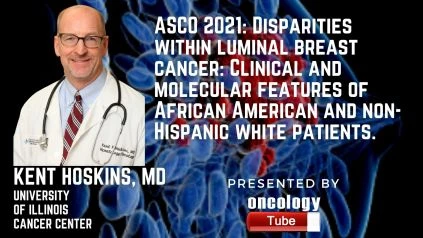Kent Hoskins, MD, Co-Leader of the Breast Cancer Research Group and Director of Cancer Genetics at the University of Illinois Cancer Center speaks about ASCO 2021 Abstract – Disparities within luminal breast cancer: Clinical and molecular features of African American and non-Hispanic white patients.
Link to Abstract:
https://meetinglibrary.asco.org/record/198997/abstract
Background information:
Despite equivalent therapies, African American breast cancer patients (AA) are diagnosed younger, have more high-risk characteristics, and have poorer clinical outcomes than non-Hispanic White patients (NHW). Although comorbidities like obesity and metabolic syndrome may play a role, ancestry-specific variables and the consequences of structural violence, which disproportionately affect AA people, may have an impact on tumor biology and prognosis. We recently discovered differentially expressed genes (DEGs) linked to tumor aggressiveness in AA basal tumors compared to NHW basal tumors (Sharma et al., 2020). DEGs in luminal tumors are compared between AA and NHW in this study.
Methodologies:
Patients with stage I-III breast cancer who obtain 70-gene signature (MammaPrint/MP)/80-gene signature (BluePrint/BP) testing and consent to comprehensive transcriptome and clinical data collection are included in the prospective, observational FLEX trial (NCT03053193). The study comprised AA (n=364) and NHW (n=400, random selection) patients with BP luminal tumors who were recruited from 2017 to the present. The race and ethnicity of the participants were self-reported. Because AA were younger than NHW (mean, 59 vs. 62 years, p=0.001), they were compared in an age-matched group (n= 360 AA, NHW). The R limma package was used to do differential gene expression analysis. In (1) all, (2) luminal A, (3) luminal B, and (4) luminal B, obese, comparisons were undertaken between AA and age-matched or randomly chosen NHW. DEGs with an FDR of 0.05 were statistically significant. A variety of fold change (FC) levels were tested.
The following are the outcomes:
Menopausal status, T stage, grade, and tumor type were similar in AA and age-matched NHW, but obesity, T2DM status, and nodal stage were substantially different (p0.01). AA tumors were more likely to be MP high risk (p0.001), independent of age. More DEGs (n=1070) were found in the Luminal B AA vs. age-matched NHW comparison than in the other comparisons, however, the majority were FC2. 5/6 DEGs (PSPH, NOTCH2NL, POLR1A, MAP1LC3P, and RPS26P10) were also seen in basal tumors (Nunes et al. 2019). Two (PSPH and LINC01139) of the nine DEGs (FC>1.7) observed in the luminal B age-matched comparison were also detected in the luminal B, obese category. DEGs that were consistently elevated in AA were linked to metabolism, translation, and the cellular stress response.
Final Thoughts:
When adjusting for age, obesity, and genomic categorization, we discovered substantial transcriptome differences between luminal tumors from AA and NHW. A subset of DEGs in luminal B cancers was identical to those in Basal tumors, suggesting that race-related variables promote DEGs in both types of cancers. DEGs were also discovered that may be specific to AA luminal cancers. This study reveals that certain biological differences in breast cancers may be due to patient ancestry or shared unfavorable socioeconomic exposures, emphasizing the need of include patients from a variety of backgrounds in treatment studies.
Clinical trial information: NCT03053193
http://clinicaltrials.gov/show/NCT03053193

